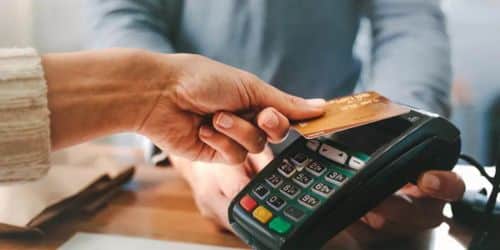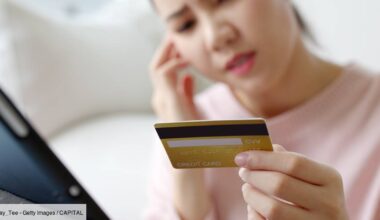The way we pay for things is changing. As a result of the coronavirus pandemic, an increasing number of people are opting to shop online in order to avoid social interaction. That is not to say that people no longer visit physical stores, but they do prefer to use contactless payment methods, such as a mobile E-Wallet or a contactless credit or debit card. Essentially, we are going toward a cashless society. If you want to stay on top of this trend, you should think about which contactless payment app is appropriate for you. Here’s all you need to know about contactless payment, including the dangers and benefits of using contactless cards.
What Is Contactless Payment?
Contactless payment refers to a safe way for consumers to buy goods or services using a debit, credit, smartcard, or other payment device that employs radio frequency identification (RFID) technology and near-field communication (NFC). This form of payment involves tapping a payment card or other device near a point-of-sale terminal equipped with contactless payment technology. Some banks and retailers refer to contactless payment as tap-and-go or tap.
Contactless payment enables customers to pay for products and services with their debit or credit cards equipped with RFID technology (also known as chip cards) or other payment devices without having to swipe, enter a personal identification number (PIN), or sign for a transaction. Point-of-sale terminals with a specific emblem indicating the technology, similar to the wifi logo but flipped on its side, are used by merchants who take contactless payments.
This is how it works. When the merchant’s system encourages the consumer to pay, they bring the card close to the terminal’s contactless payment icon. The information from the chip on the card is communicated electronically to the bank. When the system accepts the tap, a beep, green light, or checkmark is displayed to the customer. The transaction is finalized once the approval is received.
With the advancement of wireless technology and the proliferation of smart gadgets, consumers can now connect their credit cards to a device such as a smartphone, smartwatch, or fitness tracker to pay to utilize the contactless system. This is accomplished by installing a payment app, such as Apple Pay, which allows consumers to securely store credit and debit card information in order to make purchases by tapping a smartphone or Apple iWatch.
Contactless Payment History
Contactless payment has been present since the 1990s, although just a few shops and retailers used it at the time. It has now grown to include thousands of banks, credit card firms, merchants, and retailers all around the world.
The transportation authority in Seoul, South Korea, provided one of the world’s first contactless payment systems. The technology, which debuted in 1995 as UPass, provides riders with a quick and convenient way to pay for bus travel utilizing the contactless system. In 1997, Mobil introduced one of the first contactless payment systems, Speedpass, which allowed users to pay for gas with a unique fob loaded with cash at participating gas stations. After London’s transit agency implemented its prepaid contactless Oyster Card system for transit riders to use on the Underground, the contactless system gained popularity in the United Kingdom. In 2014, the agency began allowing commuters to use contactless credit and debit cards on the metro system.
The United States market has been extremely sluggish to implement contactless payment. According to a 2018 estimate from consulting company A.T. Kearney, contactless payment methods account for over 20% of all transactions in Australia, Canada, South Korea, and the United Kingdom. Kearney. According to the survey, Americans still prefer physical cash to payment cards, with about 50 billion cash transactions every year, accounting for 26% of all consumer payment transactions. The American market is more fragmented due to the number of merchants and banks.
Treat a digital wallet as you would cash—use device locks and set up notifications for all of your credit cards in case of fraud or theft.
Examples of Contactless Payment Apps
Banks and other financial institutions accept contactless payments. However, other businesses have jumped on board, offering their own versions of contactless payment. For example, Google and Android introduced NFC-enabled pay systems compatible with their handsets in 2011, while Apple launched Apple Pay—its own version of the digital wallet—in 2014. Here are some contactless payment apps available.
#1. Apple Pay
With Apple dominating the mobile phone market, it’s no surprise that Apple Pay appears on our list of Visa contactless payment apps. You can use any bank card and attach it to Apple Pay, and you can instantly use the app with a simple touch gesture at the checkout. You may also connect your desktop Mac to Apple Pay and utilize the same mechanism to make online payments as an added advantage.
NFC technology, an acronym for Near-Field Communications, is used to secure Apple Pay. This implies that your payment information can be communicated easily by placing your phone near a contactless reader, and data is fully secured to safeguard your data’s security.
#2. Google Pay
Even if you don’t own an iPhone, there are numerous contactless payment apps available. Android users may download a wide range of apps, and Google Pay is a fantastic contactless payment solution that is also enabled by NFC technology for your convenience and security. The software was previously known as Android Pay, and it is approved by the majority of big retailers.
Google Pay is an excellent contactless payment software since it lets users make peer-to-peer transactions in some countries, including the United States, India, and Singapore, as well as pay for in-app and online purchases. Remember that, like other contactless payment apps, users of the peer-to-peer service in those countries will have to pay fees to transfer funds between their G Pay balance and their credit or debit cards.
#3. Samsung Pay
Samsung, like the other major technology companies, offers its own payment service known as Samsung Pay, which is supported by both NFC and the older MST (Magnetic Secure Transaction) technology. This means it is also compatible with older POS terminals that use magnetic stripe reading technology. This E-Wallet solution is an excellent contactless payment app because it includes a rewards program for both credit and debit cards.
#4. Cash App
Cash App is a third-party payment tool provided by the fintech Titans Square that allows you to attach your debit card or even purchase or conduct transactions using Bitcoin as a payment currency. The app, like Apple and Google Pay, maintains a separate balance from your primary bank account, from which debits are debited. One intriguing feature is the possibility to send payments to other Cash App users using an alias, preserving your anonymity.
What are Contactless Payment Limits?
The maximum amount that can be spent in a single transaction without requiring a PIN or signature is known as the contactless payment limit, also known as the CVM (cardholder verification method) limit. These restrictions exist to assist in decreasing fraud and safeguard consumers.
Each country establishes its own contactless limit, which can differ based on the type of card used. In some cases, this limit leaves it up to the issuing or acquiring bank to set the maximum for their cards.
In response to the COVID-19 epidemic, the contactless limit in the United Kingdom was raised from £30 to £45 in April 2020. However, the UK was not the first country to increase its limits—Australia, Canada, and New Zealand had all done so in the preceding months.
In the United States, prominent issuers including American Express, Chase, and Citi have increased their contactless payment limitations. American Express was the first to modify its limit, raising it from $30 to $80 in May 2020.
How Contactless Limits Affect Businesses and Consumers
There are several reasons why contactless restrictions are important for both organizations and consumers:
For Companies
A larger limit helps businesses reduce friction at the point of sale. This is especially crucial in congested places or during peak seasons, such as the Christmas season. Customers may finish their transactions more quickly, which helps to reduce queues and wait times.
For Customers
A greater contactless limit provides more ease and flexibility in paying money for consumers. It also helps to lessen the demand for cash, which is vital in the current environment.
What Are the Consequences of Greater Contactless Payment Limits?
Businesses and customers should be aware of the following implications of greater contactless limits:
For Companies
Businesses must guarantee that their POS (point of sale) system can take contactless payments up to the increased maximum. If you’re unsure, contact your provider or acquirer. Your signage and marketing materials may also need to be updated to reflect the new limit.
For Customers
With a greater limit, you can utilize your contactless payment method for more expensive consumer purchases. However, keep in mind that your contactless limit is not infinite. If you attempt to purchase something that exceeds the limit, you will be prompted to enter your PIN or sign for the transaction.
Dangers Of Using Contactless Cards
The risks of using contactless cards are related to the likelihood of skimming. However, while fraudsters may be able to obtain some information from your credit card, the information they obtain is usually insufficient to complete a purchase.
This is due to the fact that a typical card transaction requires the account number, expiration date, security code on the back of the card (CVV), and/or the ZIP code from the billing address.
Contactless Card Safety Concerns
#1. Skimming at close range.
Contactless cards use a short-range radio frequency identification (RFID) antenna that only transmits digital data within a very short range. RFID readers could be used by “skimmers” to harvest data from contactless cards from a short distance and use the card data to access your account information and steal money.
#2. Making duplicate cards.
Contactless credit cards still have a magnetic stripe, which means that the information on the magnetic stripe can be cloned and exploited by others. However, the stolen information would only be valid for swiped purchases. Even in such circumstances, an issuer’s fraud liability guarantee protects you from having to pay for fraudulent card transactions.
#3. Misplaced or stolen cards
Although contactless credit cards are technologically secure, there is a disadvantage for lost or stolen contactless cards. For modest purchases, no PIN or signature is usually required when making a contactless payment. As a result, if your card is lost or stolen, it could be used by someone else without your knowledge.
When you use EMV chip cards or contactless credit cards to make a payment, they provide the reader with a one-time, unique code that identifies the transaction. This is a dynamic number that cannot be copied. EMV chip cards and contactless credit cards are therefore more secure than swiping your card’s magnetic stripe.
Benefits of Contactless Payments
Consumers became increasingly interested in contactless payments as a strategy to decrease physical connection as COVID-19 spread over the world. While retailers have been moving toward low- and no-touch payments for years, the pandemic appears to have accelerated contactless payment adoption significantly.
According to Appriss Retail data, contactless payments as a percentage of total purchases more than doubled from January to July 2020. Contactless payment refers to a variety of payment methods, including e-wallets, tap-to-pay cards, and mobile devices.
Customers’ enthusiasm for contactless payments is likely to stay as businesses look ahead to the coming year. However, these payments provide some additional benefits to your customers and company operations aside from meeting an immediate need.
Here are four potential benefits of contactless payments:
#1. Reduces Physical Contact
Despite its obviousness, this remains a significant driver of contactless payment adoption as we struggle to reduce virus spread. According to the Appriss Retail analysis, cash payments at key firms that stayed open during the COVID-related shutdowns decreased considerably.
At the same time, the use of contactless payments increased, as did the use of credit and debit cards. That’s partly because people believe paper money is filthy, and they’re not incorrect. Even before the epidemic, investigations revealed that 90% of banknotes contains bacteria of some kind. Throughout the crisis, the U.S. The Federal Reserve even started quarantining US cash returned from overseas.
#2. Enhanced Security
Aside from public health concerns, contactless payments are also less vulnerable to fraud. Most contactless payments rely on either credit card chips, which allow consumers to simply wave their cards or completely mobile wallets. Unlike credit card magnetic strips, these payments do not send the customer’s name and card number with the transaction. To identify the transaction, the RFID chip on the card transmits a one-time code to the card reader.
Some have suggested that thieves could electronically pickpocket credit card information. However, Mastercard believes that is extremely unlikely. Even if it were possible, the thieves would still need to use the card reader’s encrypted one-time code to complete the transaction.
#3. Efficiency
The ability to pay in a seamless manner not only saves your consumers time during the transaction, but is also beneficial to your personnel. Contactless payments eliminate the need for your personnel to wait for customers to locate their credit cards or enter a PIN into a machine.
Of course, they don’t have to spend time dealing with currency. This is especially important for firms that frequently deal with long queues or a high volume of minor transactions. Restaurants, cafes, gift shops, and other businesses can improve their operational efficiency and, ideally, increase their revenue.
#4. Improve Customer Experiences
An increasing corpus of studies emphasizes the significance of allowing clients to pay via the methods they prefer. Failure to do so may jeopardize the entire purchase. Given the trend toward contactless payments, making it available as an option can enhance the customer experience.
Furthermore, the ability to pay with a tap, scan, or no-touch simplifies the payment process entirely. Employees who spend less time managing transactions and more time on customer care and improving the entire retail experience.
How Do I Pay With Contactless Payment?
Tap or hold your contactless card in close proximity to the Contactless Symbol on the checkout terminal. For debit card transactions, you may be required to enter your Personal Identification Number (PIN) or sign. If there isn’t a contactless terminal nearby, simply insert or swipe your card.
How Do I Know If My Card Is Contactless?
The EMVCo Contactless Indicator* is the RFID-like sign on a debit or credit card. It signifies that your card can be tapped to pay at a contactless payment terminal.
What Are the Disadvantages of Contactless Payment?
Because contactless payments do not require a PIN or signature authorization, lost or stolen contactless cards can be used to commit fraud.
Are All Bank Cards Now Contactless?
Most major American credit card companies now send contactless cards as standard.
How Do I Set Up Contactless on My Card?
- Launch the Google Pay app.
- Tap your profile picture in the upper right corner. Wallet.
- Swipe to the card you wish to activate, then hit Verify Now.
- If you are prompted to verify your payment method, select one from the list. …
- To complete the setup, follow the on-screen directions.
Does Contactless Cards Require PIN?
When using contactless payment, no PIN or signature is usually required.
In Conclusion,
Contactless payment refers to a safe way for consumers to buy goods or services using a debit, credit, smartcard, or other payment device that employs radio frequency identification (RFID) technology and near-field communication (NFC). Contactless payments have numerous advantages. However, businesses should be aware of a few considerations. If you don’t already accept contactless payments, your employees may need to provide some upfront customer education, explaining what the choice is and how it works for those who are unaware. And, because it is still relatively new, some customers may be uninterested.
There’s also the issue of fees and costs. Most newer payment terminals include built-in contactless payment capability for the latter. If yours is older, you may need to replace some of your equipment. Furthermore, depending on the payment method, you may be charged additional fees to accept contactless payments. This is something to look into to ensure you’re accounting for the extra cost.
Related Articles
- NFC PAYMENT: How to Use It, Payment & All You Need to Know
- EMV: What It Means And How It Works
- HOW DO YOU USE APPLE PAY: All You Need To Know
- IS APPLE PAY SAFE? What are the Downsides?






